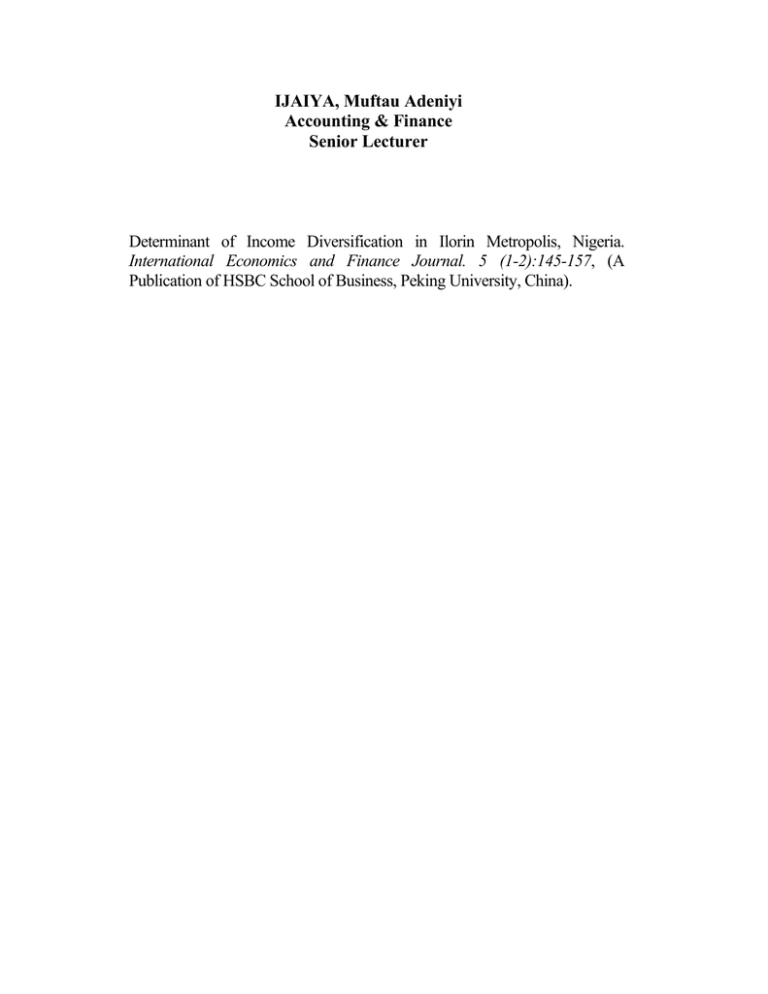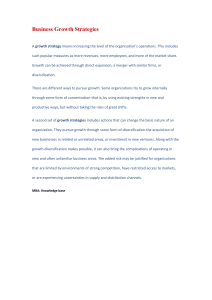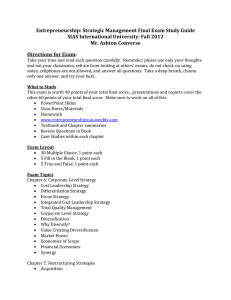IJAIYA, Muftau Adeniyi Accounting & Finance Senior Lecturer
advertisement

IJAIYA, Muftau Adeniyi Accounting & Finance Senior Lecturer Determinant of Income Diversification in Ilorin Metropolis, Nigeria. International Economics and Finance Journal. 5 (1-2):145-157, (A Publication of HSBC School of Business, Peking University, China). INTERNATIONAL ECONOMICS & FINANCE JOURNAL Vol. 5, Nos. 1-2, January-December (2010) : 145-157 DETERMINANTS OF INCOME DIVERSIFICATION IN ILORIN METROPOLIS, NIGERIA MukailaA. Ijaiya*, Gafar T. Ijaiya**, RajiA. Bello***, MuftauA. Ijaiya**** Michael A. Ajayi***** and Sidikat L. Adeyemi****** Abstract: This paper examines the determinants of income diversification in Ilorin metropolis, using a collection of household data, the Simpson Index of Diversity (SID) as a measure of income diversity, a multiple regression analysis of the Ordinary Least Square and qualitative social assessment method. The result obtained indicates that factors like household size, marital and educational status of the respondents, their access to electricity, commodity markets , health care services and information have to some extent influenced income diversification, with variables like the gender and age of the respondents, their residential location, access to social capital, their income, access to credit markets having little or no influence on the outcome of the Study, because they fall short of our a-priori expectations. Given these results measures such as the improvement in the existing electricity supply system, improvement and maintenance of road networks and the means of traveling to markets, provision of health care services and security, provision of information on the condition of the market, prevailing prices and types of commodities, promotion of social capital and the improvement and expansion of the existing credit markets in the metropolis were suggested. Key words: Income, Diversification, Ilorin 1. INTRODUCTION The continuous increase in poverty in Nigeria 1, the dwindling nature of income of individual, the increase in the rate of inflation 2, the deteriorating state of the nation's economy, especially with the introduction of structural adjustment programme in the mid 1980s* has over the years made most people, especially low income earners engaged themselves m other type of occupations than their main occupation in order to supplement their income. Th.s strategy of supplementing income from other jobs, often referred to as income diversification is a form of risk management strategy aimed at cushioning the effects of shocks (economic and agro-climate), poverty reduction, reduction in income inequality, consumption stability and over all improvement in the standard of living of the *Lectures in the Department of General Studies, Federal University of Technology Minna **Lectures in the Department of Economics, University of Ilorin, Nigeria (Corresponding Author- E-mailgtijatya@yahoo.com andgtijaiya@hotmail.com. ***Lectures in the Department of Economics, University of Ilorin, Nigeria. ****Lectures in the Department of Accounting and Finance, University of Ilorin, Nigeria *****Lectures in the Department of Accounting and Finance, University of Ilorin,' Nigeria ******Lectures in the Department of Business Administration, University of Ilorin', Ilorin, Nigeria people (Reardon 1997; Barrett, et al. 2000; Abdulai and CroceRees 2001; Barrett, et al. 2001; Block and Webb, 2001; Deininger and Olintro 2001; Little 2001; Woldenhanna and Oskan 2001; Warren 2002; Minot, et al. 2006; Adugna 2006). Several studies have indicated that for income diversification to achieve some of its set objectives, factors like household's geographic location, headship of household, head of household's age, gender, marital and education status, household size and composition, availability of infrastructural facilities, e.g. good road network, railway line, electricity, health care facilities and information, access to commodity and credit markets, human and social capital must be taken into consideration (Barrett and Reardon 2000; Barrett et al. 2001; Ersado 2006; Minot, et al. 2006). With some of these factors it is believed that, individuals, communities and the government alike will be able to evolve policy reforms that geared towards improving income diversification strategy. In other words, a blow-byblow account of the factors that determine income diversification in Ilorin metropolis must be obtained so as to provide direction for such reforms, otherwise, policies will be targeted randomly without an idea of which factors(s) is/are stronger at determining income diversification as a coping strategy among the people living in Ilorin metropolis. To accomplish this, this paper first identified some of the key factors that determine income diversification. Second, with a set of household data, index of income diversity, multiple regression analysis and qualitative social assessment method, the paper then examines the relative contribution(s) of these factors to income diversification in Ilorin metropolis. 2. CONCEPTUAL CLARIFICATION OF INCOME DIVERSIFICATION (a) Meaning Income diversification is referred to as an increase in the number of sources of income or the balance among the different sources of income. When linked to farm and non-farm activities in the rural areas, income diversification is often used to described expansion in the importance of non-crop or non-farm income. Non-farm income includes both off-farm wage labour/transfers and non-farm self-employment. Thus, diversification into non-farm activities usually implies more diversity in income sources (Reardon 1997; Barrett, et al. 2000; Abdulai and CroceRees 2001; Barrett, et al. 2001; Deininger and Olintrp 2001; Little 2001; Woldenhanna and Oskan 2001; Minot, et al. 2006; Adugna 2006). (b) Determinants of Income Diversification From the point of the rural economy, many reasons are said to induce income diversification out of farming into non-farm activities. Sometimes diversification is born out of desperation, sometimes of opportunity. Risk may play a role, but is not a necessary condition for individuals to choose to diversify. Some diversification is related to diminishing or time-varying returns to labour or land. Some other types are attributable to market failure (e.g. for credit) or friction (e.g. for mobility or entry into high-return niches). And still another cause is risk management, either ex-ante mitigation through portfolio choice or ex-post coping through adaptation to shocks (Barrett and Reardon 2000 and Barrett et al. 2001). Barrett and Reardon (2000) and Barrett et al. (2001) also reiterates that income diversification as a rural phenomena depends on three factors: First, income diversification commonly increases with total household income because households have the means to hurdle investment entry barriers to non-farm activities and because greater wealth in the local economy generate increased demand for non-farm goods and services. Thus, if income growth continues then, so should diversification increase. Second, in the rural area, development expands market access, thus inducing a shift from the production of traditional goods to satisfy local demand to modern goods for urban and foreign markets, there by stimulating diversification of the rural economy away from fanning. Third, long-term treads in infrastructure improvement, town growth and increasing population density lead to development of the rural non-farm sector that has led to more income diversification. According to Ersado (2006), the level and type of income diversification strategy depend on the access to and availability of different income generating activities, which in turn depend on a household's geographic location, socio-demographic characteristics such as headship of household, head of household's age, gender, marital and education status, household size and composition; regional/community variables like availability of infrastructural facilities, e.g. good road network, railway line, electricity, health care facilities and information, access to commodity and credit markets; human and social capital; and recurring policy changes and a measure of rainfall variability to capture household response to income risk originating from weather shocks (see also Minot, et al. 2006). Escobal (2001) reiterates that income diversification is determined by, either the "push" or "pull" factors. In his views, most households in the rural areas are "pushed" to diversify their activities off-farm if just to cope with external shocks experienced on their own farm (such as drought or a steep decline in farm gate prices) or households may be "pulled" into non-farm activity because it often pays more than farming and generates cash. To buttress this fact, he provided a standard rural household model of the determinants of income diversification as follows: Sij=f(p,zag ,znag , z k , z h , z p u , z g ) Where: S represents the net income shares coming from farm and non-farm sector activities as well as self-employment and wage-employment; p is the vector of exogenous input and output prices; and the z vectors are the different fixed assets that are available to the household. zag represents the fixed farm assets (such as land and cattle); znag, represents fixed non-farm assets such as experience in crafts and trade; zk represents other key financial assets that facilitate access to credit; zh is the vector to human capital including family size and composition (by age and gender) as well as education; zpu is the vector of key public assets such as electricity, roads, sewage, or drinking water. Finally, z includes other key assets that relates to the characteristics of the area (agro-climate, land quality, etc). (c) Significance of Income Diversification Drawing instances from the agrarian society, Minot, et al. (2006) states that most rural households adopt multiple income generating activities in order to manage risk in terms of weather change or other factors, to meet household consumption needs in the face of high transaction costs, to take advantage of positive externalities among activities, and to respond to diseconomies of scale. Diseconomies of scale can, in turn, be caused by land constraints, seasonal variation in agricultural labour productivities and heterogeneous skills in the household (see also Barrett and Reardon 2000). Studies by Escobal (2001) and Adugna (2006) also indicates that households that depend heavily on agriculture and related activities also benefited from income diversification. For instance, income diversification through off-farm activities offer an important route out of poverty, provide higher income earning, increase food consumption, generate employment and reduce income inequality. Ersado (2006) also reiterate that income diversification is a key way of ex-ante risk management or ex-post coping with shocks. And that there are several factors responsible for observed income diversification at the household level. These factors include among others: (i) self-insurance against risk in the context of missing insurance and credit markets; and (ii) an ex-post coping strategy with extra individuals and extra jobs taken because of the decline in income (see also Barrett and Reardon 2000; Barrett et al. 2001). Very few evidence on the role of income diversification exists in the urban areas. But in most rural areas of developing countries, diversification into non-farm income source is growing and accounts for a considerable share of household income. In an extensive analysis of household survey from 1970s through the 1990s, it was discovered that average non-farm income share was 42 per cent in Africa, 40 per cent in Latin America and 32 percent in Asia. Many studies in Africa find positive association between non farm diversification and household welfare and also discovered that income diversification is a coping strategy used during times of drought, like what was experienced in Burkina Faso before and after the 1984 drought, where households with greater income diversification were able to buy food and weather the effects of the drought and tend to have higher overall incomes than those who were not able to supplement their farm incomes with rural non-farm incomes (Barrett and Reardon 2000; Ersado 2006). 3. STUDY AREA AND METHODOLOGY 3.1. Study Area Ilorin is located some 300 kilometers from Lagos and 500 kilometers from Abuja the Federal Capital of Nigeria arid on Latitude North 8°30' and Longitude East 4°35' of the Equator. The city is situated in the transition zone between the forest and savanna regions of Nigeria. Presently the city is the capital of Kwara State in Nigeria and has an estimated population (by 1991 census figure) of about 572,178 people (NPC 1993, Ijaiya and Umar 2004). 3.2 Methodology In addition to the use of secondary data, a survey aimed at generating primary data on the determinants of income diversification in Ilorin metropolis was conducted between the month of January and February 2009 through the distribution of copies of questionnaire and Qualitative Social Assessment of Income Diversification (QSAID). The questionnaire was based on the World Bank Living Standards Measurement Study (LSMS) and the Nigeria’s National Bureau of Statistics’ National Integrated Surveys on Households, which among other things provided questions on the socio-demographic characteristics of the households and the description of the patterns of access to social services. The QSAID provides more in-dept information on the perceptions, experiences and constraints to income diversification (Grootaert 1986; Minot et al 2006). (b) Sample Selection Method A stratified sampling method was used in the selection of the respondents for the study. For the purpose of these study, locations within the metropolis served as the sample units4. In accordance with these sample units, a structured questionnaire was distributed to about 193 heads of households in the metropolis of which 170 responded. The issues raised in the questionnaire included the background of the respondent (i. e. age, gender, martial, educational and employment status, household size and composition), income level and source(s) including which source(s) have become more or less important over time and perception of the important income source(s), the relative contribution of the factors like household's geographic location, headship of household, availability of infrastructural facilities, e.g. good road network, electricity, health care facilities and information, access to commodity and credit markets, human and social capital to income diversification, their perceptions and experiences regarding income diversification, the role of the government in promoting new economic activities, including questions about the types of assistance rendered and the usefulness of the assistance. (c) Data Analysis Both qualitative and quantitative methods were used in analyzing the data collected for the study. The qualitative analysis was based on the perception of the respondents on the determinants of income diversification in llorin metropolis. The quantitative method comprises the use of descriptive analysis, the Simpson Index of Diversity used in measuring income diversity and a multiple regression analysis in determining the relative contribution of the factors that determine income diversification in llorin metropolis. members are faced with low transaction cost in buying or selling and with access to information, available commodities in the markets and their prices will be within reach. Gender and location of the residence of the respondents could either be positive or negative. That the outcome of the regression is negative indicates that the bulk of the respondents that are male and mostly found in the modern settlements did not matter much to the outcome of the study. In other words, the respondents found in the modern settlements and households headed by male are little or not involved in income diversity than those headed by female and found in the traditional settlements. Drawn from the perception of some of the respondents, their quest for more source of income is caused by the harsh economic situation in the country, the relatively large household size which they must feed and catered for, availability of commodity markets where goods can be brought and sold, but with merger income and poor credit markets, which on the other hand makes income diversification difficult. These results are in conformity with the study on Vietnam by Minot, et al. (2006), where it was established that the education of the household members is significantly and positively related to the number of income sources, since education opens the door to a number of different economic activities, either because of formal requirements for wage earning positions or because education (particularly literacy and numeracy) facilitate learning about new self-employment opportunities and managing them efficiently. For household size, large households with a small proposition of children and elderly people tend to have a large number of income sources. Age of the respondents, their access to social capital, income from main occupation, access to credit markets did not matter much to the outcome of this study because they fall short of our a-priori expectations. The case of social capital and access to the credit markets seems obvious given the cosmopolitan nature of Ilorin metropolis, where little or no social/kinship networks, reciprocal relationships and trust among the people exist. The lack of access to the credit markets, which should have help boost income diversification can be linked to the people's lack of awareness of the credit services available, their proximity and their reliability in either starting a business or expanding an existing one and the high interest rate and the need for collaterals that comes with the services. These assertions are also in conformity with the views of Ersado (2006) and (Escobal 2001) while comparing income diversification in the rural areas with the urban centers. 5. CONCLUSION AND RECOMMENDATIONS An empirical study of the determinants of income diversification in Ilorin metropolis was carried out using a collection of household data, the Simpson Index of Diversity (SID) as a measure of income diversity, a multiple regression analysis of the Ordinary Least Square and qualitative social assessment method. Some of the determinants considered for the study are vector of household and community characteristics. The vector of household characteristics includes household size, gender of the heads of households, who were used as the respondents, location of the residence of the respondents, age, marital and educational status of the respondents. The vector of community characteristics includes social capital measured by membership of an association, income of respondents from their main occupation, access to electricity, access to commodity markets, access to the credit markets, access to health care services and access to information. Of these variables only household size of the respondents, their marital and educational status, their access to electricity, commodity markets, health care services and information have to some extent influenced income diversification in Ilorin metropolis, with variables like the gender and age of the respondents, their residential location, access to social capital, their income, access to credit markets not adding much to the outcome of this study because they fall short of our a-priori expectations. These results thus call for measures that would in addition to improving the existing electricity supply system in the metropolis, provide access to commodity markets via the improvement and the maintenance of road networks and the means of traveling to the markets, provide health care services that are essential for good health and productivity, provide information on exiting markets, prices and commodity conditions, improve and expand the existing credit markets with serious emphasis on interest rate reduction and removal of stringent conditions for credit availability at the informal, semi-formal and formal credit institutions. Social capital, which emphasizes on membership of associations (trade/communal groups), social/kinship networks, reciprocal relationships and trust among the people should be encouraged, given its importance as a mediator in cementing relations, settling disputes and forging unity among members and as an avenue for providing members financial, social and political support in times of need and as a mechanism for removing fear of fraud and mismanagement that are detrimental to entrepreneurial development. The government at the level of the state and local government could also be of help in encouraging income diversification efforts via the provision of infrastructural facilities, micro credits, security of life and property for entrepreneurial development in the metropolis. NOTES 1. 2. 3. 4. The rate of poverty increased from 28.1 per cent in 1980 to about 70.2 percent in 2003 (Adeyemi, et.al 2007). For the persistent increase in the rate of inflation in Nigeria see CBN 2005 For the effects of Structural Adjustment Programme see Faruqee 1994: Ukpong and Iniedu 1994. The 11 sample units include among others: Oja oba, Gambari, Pakata, Oloje, Okelele, Okesuna, Oko Erin, Balogun Fulani, Gaa Akanbi, Baboko and Taiwo. REFERENCES Abdulai, A. and CroleRees, A. (2001), Determinants of Income Diversification amongst Rural Households in Southern Mali. Food Policy. Vol. 26, No 4: 437-452. Adeyemi, S. L., Ijaiya G T. and Ijaiya, B. L. (2007), Human Rights Abuse and the Incidence of Poverty in Nigeria: A Case Study of Women Operating in the Informal Sector of Kwara State, Nigeria. In UNESCO Small Grants Programme of Poverty Eradication: Building National Capacities for Research and Policy Analysis. Paris: UNESCO: 78-84. Adugna, L. (2006), The Dynamics of Income Diversification in Ethiopia, www.idas.repec.org/mab/wpapers/ 3.html. Barrett, C. B. and Reardon, T. (2000), Asset, Activity and Income Diversification among AfricanAgriculturalist: Some Practical Issues. www.ieswisc.edu/Itc/live\basgl0003a. Barrett, C. B; Bezuneh, M; Clay, D. C. and Reardon, T. (2000), Heterogonous Constraints, Incentives and Income Diversification Strategies in Rural Africa. www.ies.wisc.edu/Itc/live/basgl00008a. Barrett, C. B., Reardon, T and Webb, P. (2001), Non-farm Income Diversification and Household Livelihood Strategies in Rural Africa: Dynamics and Policy Implications. Food Policy, Vol. 26. No 4: 315-331. Block, S. and Webb, P. (2001), The Dynamics of Livelihood Diversification in Post-Famine Ethiopia. Food Policy, Vol. 26 No 4: 333 -350. Central Bank of Nigeria (CBN) (2005), Statistical Bulletin. Abuja: CBN. Deininger, K. and Olintro P. (2001), Rural Non-farm Employment and Income Diversification in Colombia. World Development, Vol. 29 No 2: 455-465. Ersado, L. (2006), Income Diversification in Zimbabwe: Welfare Implications from Urban and Rural Areas. World Bank Policy Research Working Paper No. 3964. Escobal, J (2001) The Determinants of Non-farm Income Diversification in Rural Peru World Development, Vol. 29, No. 3, 497-508. Faruqee, R. (1994), Nigeria: Ownership Abandoned. In Hussein I. Faruqee R. (eds.) Adjustment in Africa: Lessons from Country Case Studies. Washington DC: The World Bank. Greene, W. H. (2003), Econometric Analysis. Delhi: Dorling Kindersley. Grootaert, C. (1986), Measuring and Analyzing Levels of Living in Developing Countries: An Annotated Questionnaire. World Bank Living Standards Measurements Study Working Paper No. 24. Ijaiya G. T. and Umar, C. A. (2004), The Informal Sector and Formal Sector Inter-Linkages and the Incidence of Poverty in Nigeria: A Case Study of Ilorin Metropolis. Africa Development, Vol. XXIX. No.3:84-102. Little, P. D. (2001), Income Diversification among East African Pastoralists. Global Livestock Collaborative Research Support Programme. Research Brief. 01-08. Minot, N; Epprecht, M; Anh T. T. T. and Trung L . Q. (2006), Income Diversification and Poverty in the Northern Uplands of Vietnam. International Policy Research Institute, Research Report No. 145. National Population Commission (NPC) (1993), Population in Census 1991: National Summary. NPC: Lagos. Oyeniyi, T. A. (1997), Fundamental Principles of Econometrics. Lagos: Cader Publication Ltd. Reardon, T. (1997), Using Evidence of Household Income Diversification to Inform Study of the Rural Non-farm Labour Market in Africa. World Development, Vol. 25, No. 5, 735-747. Schgtman, A., Berdegue, J. and Modrego, F. (2006), Income Diversification through Agricultural Development, www.rimisp.org/getdoc.php. Ukpong I. I. and Iniedu P. U. (1994), The Impact of Structural Adjustment Programme on Nigeria's Agriculture. The Nigerian Journal of Economic and Social Studies, Vol. 36, No. 2: 353-367. Warren, P. (2002), Livelihood Diversification and Enterprise Development: An Initial Exploration of Concepts and Issues. FAO, Livelihood Support Programme Working Paper No. 4. Woldenhama, T. and Oskan, A. (2001), Income Diversification and Entry Barriers: Evidence from the Tigray Region of Northern Ethiopia. Food Policy, Vol. 26 No. 4: 351-365.




